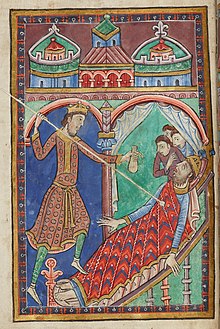
Herman the Archdeacon (also Hermann the Archdeacon[2] and Hermann of Bury,[3] born before 1040, died late 1090s) was a member of the household of Herfast, Bishop of East Anglia, in the 1070s and 1080s. Thereafter, he was a monk of Bury St Edmunds Abbey in Suffolk for the rest of his life.
Herman was probably born in Germany. Around 1070 he entered Herfast's household, and according to a later source he became the bishop's archdeacon, which was at that time an important secretarial position. He assisted Herfast in his unsuccessful campaign to move his bishopric to Bury St Edmunds Abbey, against the opposition of its abbot, and helped to bring about a temporary reconciliation between the two men. He remained with the bishop until his death in 1084, but he later regretted supporting his campaign to move the bishopric and himself moved to the abbey by 1092.
Herman was a colourful character and a theatrical preacher, but he is chiefly known as an able scholar who wrote the Miracles of St Edmund, a hagiographical account of miracles believed to have been performed by Edmund, King of East Anglia after his death at the hands of a Danish Viking army in 869. Herman's account also covered the history of the eponymous abbey. After his death, two revised versions of his Miracles were written, a shortened anonymous work which cut out the historical information, and another by Goscelin, which was hostile to Herman.
- ^ Life and Miracles, Morgan Library, MS M.736 fol. 21v; Licence 2014, p. 153.
- ^ Gransden 1995, p. 1.
- ^ Williams 2004.